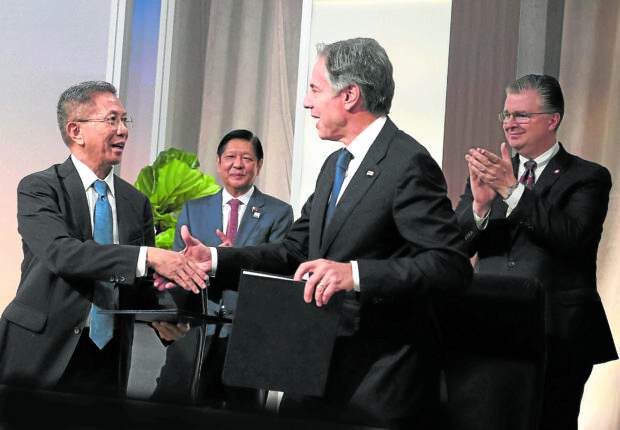
BREAKTHROUGH Energy Secretary Raphael Lotilla and US Secretary of State Antony Blinken seal with a handshake the newly signed 123 agreement at George Moscone Convention Center in San Francisco, California, on Thursday. Behind them are President Marcos and US Assistant Secretary of State Daniel Kritenbrink. —MARIANNE BERMUDEZ
SAN FRANCISCO—The Philippines and the United States on Friday signed a breakthrough agreement on nuclear energy cooperation that would allow Washington to export nuclear equipment and technology to Manila, a deal that took a year to negotiate and now expected to boost investments and lower energy costs in the country.
Energy Secretary Raphael Lotilla and US Secretary of State Anthony Blinken signed the 123 agreement, or the “peaceful nuclear cooperation agreement,” on the sidelines of the Asia-Pacific Cooperation (Apec) Summit here. The deal, which still needs US Congress approval, provides the legal basis for allowing American companies to export nuclear fuel, reactors, equipment and other related specialized materials to the Philippines.
The United States has such civil nuclear agreements with countries, such as Russia, China, Canada, South Korea, the United Kingdom, Japan, Taiwan, Turkey, Ukraine, the United Arab Emirates and Vietnam.
Known as 123 agreements after their section in the US Atomic Energy Act, the pacts are critical for investment by US nuclear companies, which are wary of running afoul of laws related to proliferation.
Small modular reactors
“When this agreement goes into effect, the United States will be able to share equipment and material with the Philippines as they work to develop small modular reactors and other civilian nuclear energy infrastructure, and we’ll do so while following the highest standards of safety and security,” Blinken said in his speech during the signing ceremony.
Negotiations for the agreement started in November 2022, when Vice President Kamala Harris visited the Philippines.
“So just one year later, we’re signing the agreement and that is the fastest that the United States has ever negotiated this kind of agreement,” Blinken said.
Washington and Manila may now work together on the deployment of advanced technologies “to support climate goals as well as critical energy security and baseload power needs within the Philippines,” the US Department of State said in a separate statement.
“This agreement also establishes nonproliferation criteria that both governments must uphold, such as observing specific standards for covered items used in civil nuclear energy programs, including International Atomic Energy Agency safeguards; physical protection of covered items; and limitations on enriching, reprocessing and transferring specific items without the other party’s consent,” it added.
The deal clears a path for US investment to jumpstart atomic power in a country racing to expand its electricity supply.
President Marcos, who has become a close US ally in his more than one year in power and was on hand when his energy secretary signed the pact, said “We see nuclear energy becoming a part of the Philippine energy mix by 2032, and we will be more than happy to pursue this path with the United States as one of our partners.” The Philippines has some of the region’s highest energy costs and faces a looming crisis as the Malampaya gas field, which supplies about 40 percent of power to the archipelago’s main island Luzon, is expected to run dry within a few years.
As part of its climate goals, the Philippines also aims for renewable energy—not including nuclear—to make up 35 percent of power generation by 2030 and 50 percent by 2040.
Past attempts
Previous attempts to pursue nuclear energy in the Philippines were halted over safety concerns, but Marcos has discussed the possibility of reviving a mothballed nuclear power plant, built in response to an energy crisis during the rule of the late Philippines strongman and his namesake father.
Completed in 1984, the Bataan Nuclear Power Plant was mothballed two years later following the ouster of the older Marcos, the deadly Chernobyl nuclear disaster and corruption allegations.
Lotilla, in his speech during the signing, said the 1987 Philippine Constitution “remained open to all peaceful uses of nuclear energy. The new nuclear deal would be “extremely important to lower energy costs” in the country, Philippine Ambassador to the United States Jose Manuel Romualdez told the Inquirer.
AboitizPower Corp., one of two major Philippine power firms exploring nuclear energy, hailed the agreement as a first step “in the multiyear journey to unlock the possibilities of nuclear power generation in the Philippines.”
Challenges ahead
Still, AboitizPower president and chief executive Emmanuel Rubio said there would still be “considerable challenges” down that path.
“There are many more steps ahead in the policy arena; from establishing a regulatory body to ensure safety, updating technical expertise in the bureaucracy and preparing the talent pipeline of nuclear engineers,” Rubio said, citing some examples.
“We will approach any future investment program with the necessary prudence, capability and understanding of the commercial, technical and social feasibility of this technology,” he said.
In August, AboitizPower disclosed it was in talks with US-based nuclear developers NuScale Power LLC and Ultra Safe Nuclear Corp. (USNC).
On Thursday, power distributor Manila Electric Co. (Meralco) said it had formalized a partnership with USNC to study the deployment of small modular reactors.
USNC will conduct a four-month feasibility study to “familiarize Meralco” with its micro modular reactor energy system and assess how this could be effectively used locally.